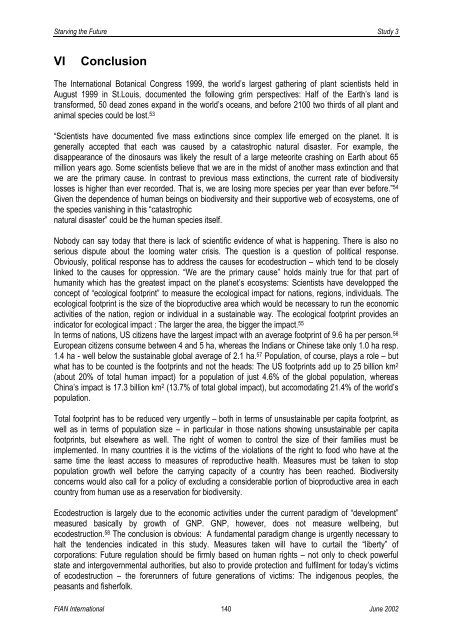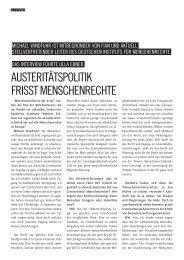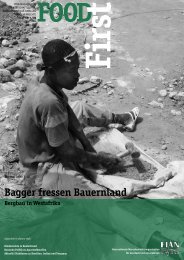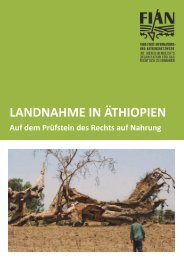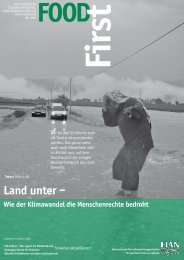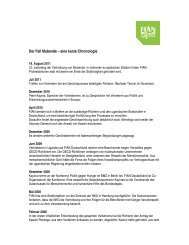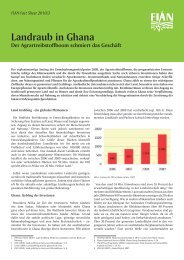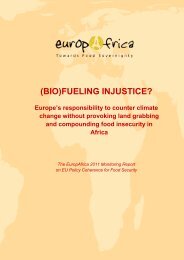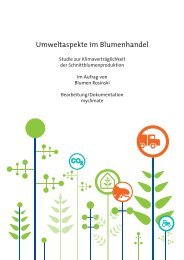Study 3: Ecodestruction and the Right to Food: The Cases of Water ...
Study 3: Ecodestruction and the Right to Food: The Cases of Water ...
Study 3: Ecodestruction and the Right to Food: The Cases of Water ...
Create successful ePaper yourself
Turn your PDF publications into a flip-book with our unique Google optimized e-Paper software.
Starving <strong>the</strong> Future <strong>Study</strong> 3<br />
VI Conclusion<br />
<strong>The</strong> International Botanical Congress 1999, <strong>the</strong> world’s largest ga<strong>the</strong>ring <strong>of</strong> plant scientists held in<br />
August 1999 in St.Louis, documented <strong>the</strong> following grim perspectives: Half <strong>of</strong> <strong>the</strong> Earth’s l<strong>and</strong> is<br />
transformed, 50 dead zones exp<strong>and</strong> in <strong>the</strong> world’s oceans, <strong>and</strong> before 2100 two thirds <strong>of</strong> all plant <strong>and</strong><br />
animal species could be lost. 53<br />
“Scientists have documented five mass extinctions since complex life emerged on <strong>the</strong> planet. It is<br />
generally accepted that each was caused by a catastrophic natural disaster. For example, <strong>the</strong><br />
disappearance <strong>of</strong> <strong>the</strong> dinosaurs was likely <strong>the</strong> result <strong>of</strong> a large meteorite crashing on Earth about 65<br />
million years ago. Some scientists believe that we are in <strong>the</strong> midst <strong>of</strong> ano<strong>the</strong>r mass extinction <strong>and</strong> that<br />
we are <strong>the</strong> primary cause. In contrast <strong>to</strong> previous mass extinctions, <strong>the</strong> current rate <strong>of</strong> biodiversity<br />
losses is higher than ever recorded. That is, we are losing more species per year than ever before.” 54<br />
Given <strong>the</strong> dependence <strong>of</strong> human beings on biodiversity <strong>and</strong> <strong>the</strong>ir supportive web <strong>of</strong> ecosystems, one <strong>of</strong><br />
<strong>the</strong> species vanishing in this “catastrophic<br />
natural disaster” could be <strong>the</strong> human species itself.<br />
Nobody can say <strong>to</strong>day that <strong>the</strong>re is lack <strong>of</strong> scientific evidence <strong>of</strong> what is happening. <strong>The</strong>re is also no<br />
serious dispute about <strong>the</strong> looming water crisis. <strong>The</strong> question is a question <strong>of</strong> political response.<br />
Obviously, political response has <strong>to</strong> address <strong>the</strong> causes for ecodestruction – which tend <strong>to</strong> be closely<br />
linked <strong>to</strong> <strong>the</strong> causes for oppression. “We are <strong>the</strong> primary cause” holds mainly true for that part <strong>of</strong><br />
humanity which has <strong>the</strong> greatest impact on <strong>the</strong> planet’s ecosystems: Scientists have developped <strong>the</strong><br />
concept <strong>of</strong> “ecological footprint” <strong>to</strong> measure <strong>the</strong> ecological impact for nations, regions, individuals. <strong>The</strong><br />
ecological footprint is <strong>the</strong> size <strong>of</strong> <strong>the</strong> bioproductive area which would be necessary <strong>to</strong> run <strong>the</strong> economic<br />
activities <strong>of</strong> <strong>the</strong> nation, region or individual in a sustainable way. <strong>The</strong> ecological footprint provides an<br />
indica<strong>to</strong>r for ecological impact : <strong>The</strong> larger <strong>the</strong> area, <strong>the</strong> bigger <strong>the</strong> impact. 55<br />
In terms <strong>of</strong> nations, US citizens have <strong>the</strong> largest impact with an average footprint <strong>of</strong> 9.6 ha per person. 56<br />
European citizens consume between 4 <strong>and</strong> 5 ha, whereas <strong>the</strong> Indians or Chinese take only 1.0 ha resp.<br />
1.4 ha - well below <strong>the</strong> sustainable global average <strong>of</strong> 2.1 ha. 57 Population, <strong>of</strong> course, plays a role – but<br />
what has <strong>to</strong> be counted is <strong>the</strong> footprints <strong>and</strong> not <strong>the</strong> heads: <strong>The</strong> US footprints add up <strong>to</strong> 25 billion km 2<br />
(about 20% <strong>of</strong> <strong>to</strong>tal human impact) for a population <strong>of</strong> just 4.6% <strong>of</strong> <strong>the</strong> global population, whereas<br />
China’s impact is 17.3 billion km 2 (13.7% <strong>of</strong> <strong>to</strong>tal global impact), but accomodating 21.4% <strong>of</strong> <strong>the</strong> world’s<br />
population.<br />
Total footprint has <strong>to</strong> be reduced very urgently – both in terms <strong>of</strong> unsustainable per capita footprint, as<br />
well as in terms <strong>of</strong> population size – in particular in those nations showing unsustainable per capita<br />
footprints, but elsewhere as well. <strong>The</strong> right <strong>of</strong> women <strong>to</strong> control <strong>the</strong> size <strong>of</strong> <strong>the</strong>ir families must be<br />
implemented. In many countries it is <strong>the</strong> victims <strong>of</strong> <strong>the</strong> violations <strong>of</strong> <strong>the</strong> right <strong>to</strong> food who have at <strong>the</strong><br />
same time <strong>the</strong> least access <strong>to</strong> measures <strong>of</strong> reproductive health. Measures must be taken <strong>to</strong> s<strong>to</strong>p<br />
population growth well before <strong>the</strong> carrying capacity <strong>of</strong> a country has been reached. Biodiversity<br />
concerns would also call for a policy <strong>of</strong> excluding a considerable portion <strong>of</strong> bioproductive area in each<br />
country from human use as a reservation for biodiversity.<br />
<strong>Ecodestruction</strong> is largely due <strong>to</strong> <strong>the</strong> economic activities under <strong>the</strong> current paradigm <strong>of</strong> “development”<br />
measured basically by growth <strong>of</strong> GNP. GNP, however, does not measure wellbeing, but<br />
ecodestruction. 58 <strong>The</strong> conclusion is obvious: A fundamental paradigm change is urgently necessary <strong>to</strong><br />
halt <strong>the</strong> tendencies indicated in this study. Measures taken will have <strong>to</strong> curtail <strong>the</strong> “liberty” <strong>of</strong><br />
corporations: Future regulation should be firmly based on human rights – not only <strong>to</strong> check powerful<br />
state <strong>and</strong> intergovernmental authorities, but also <strong>to</strong> provide protection <strong>and</strong> fulfilment for <strong>to</strong>day’s victims<br />
<strong>of</strong> ecodestruction – <strong>the</strong> forerunners <strong>of</strong> future generations <strong>of</strong> victims: <strong>The</strong> indigenous peoples, <strong>the</strong><br />
peasants <strong>and</strong> fisherfolk.<br />
FIAN International 140<br />
June 2002


